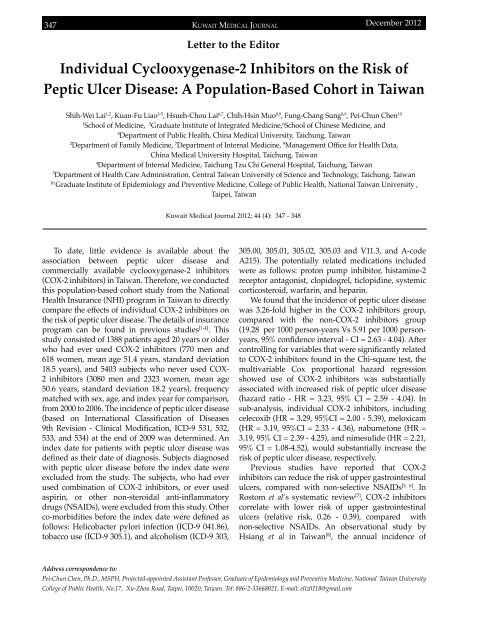Vol 44 # 4 December 2012 - Kma.org.kw
Vol 44 # 4 December 2012 - Kma.org.kw
Vol 44 # 4 December 2012 - Kma.org.kw
You also want an ePaper? Increase the reach of your titles
YUMPU automatically turns print PDFs into web optimized ePapers that Google loves.
347<br />
KUWAIT MEDICAL JOURNAL<br />
<strong>December</strong> <strong>2012</strong><br />
Letter to the Editor<br />
Individual Cyclooxygenase-2 Inhibitors on the Risk of<br />
Peptic Ulcer Disease: A Population-Based Cohort in Taiwan<br />
Shih-Wei Lai 1,2 , Kuan-Fu Liao 3-5 , Hsueh-Chou Lai 6,7 , Chih-Hsin Muo 8,9 , Fung-Chang Sung 8,9 , Pei-Chun Chen 10<br />
1<br />
School of Medicine, 3 Graduate Institute of Integrated Medicine, 6 School of Chinese Medicine, and<br />
8<br />
Department of Public Health, China Medical University, Taichung, Taiwan<br />
2<br />
Department of Family Medicine, 7 Department of Internal Medicine, 9 Management Office for Health Data,<br />
China Medical University Hospital, Taichung, Taiwan<br />
4<br />
Department of Internal Medicine, Taichung Tzu Chi General Hospital, Taichung, Taiwan<br />
5<br />
Department of Health Care Administration, Central Taiwan University of Science and Technology, Taichung, Taiwan<br />
10<br />
Graduate Institute of Epidemiology and Preventive Medicine, College of Public Health, National Taiwan University ,<br />
Taipei, Taiwan<br />
Kuwait Medical Journal <strong>2012</strong>; <strong>44</strong> (4): 347 - 348<br />
To date, little evidence is available about the<br />
association between peptic ulcer disease and<br />
commercially available cyclooxygenase-2 inhibitors<br />
(COX-2 inhibitors) in Taiwan. Therefore, we conducted<br />
this population-based cohort study from the National<br />
Health Insurance (NHI) program in Taiwan to directly<br />
compare the effects of individual COX-2 inhibitors on<br />
the risk of peptic ulcer disease. The details of insurance<br />
program can be found in previous studies [1-4] . This<br />
study consisted of 1388 patients aged 20 years or older<br />
who had ever used COX-2 inhibitors (770 men and<br />
618 women, mean age 51.4 years, standard deviation<br />
18.5 years), and 5403 subjects who never used COX-<br />
2 inhibitors (3080 men and 2323 women, mean age<br />
50.6 years, standard deviation 18.2 years), frequency<br />
matched with sex, age, and index year for comparison,<br />
from 2000 to 2006. The incidence of peptic ulcer disease<br />
(based on International Classification of Diseases<br />
9th Revision - Clinical Modification, ICD-9 531, 532,<br />
533, and 534) at the end of 2009 was determined. An<br />
index date for patients with peptic ulcer disease was<br />
defined as their date of diagnosis. Subjects diagnosed<br />
with peptic ulcer disease before the index date were<br />
excluded from the study. The subjects, who had ever<br />
used combination of COX-2 inhibitors, or ever used<br />
aspirin, or other non-steroidal anti-inflammatory<br />
drugs (NSAIDs), were excluded from this study. Other<br />
co-morbidities before the index date were defined as<br />
follows: Helicobacter pylori infection (ICD-9 041.86),<br />
tobacco use (ICD-9 305.1), and alcoholism (ICD-9 303,<br />
305.00, 305.01, 305.02, 305.03 and V11.3, and A-code<br />
A215). The potentially related medications included<br />
were as follows: proton pump inhibitor, histamine-2<br />
receptor antagonist, clopidogrel, ticlopidine, systemic<br />
corticosteroid, warfarin, and heparin.<br />
We found that the incidence of peptic ulcer disease<br />
was 3.26-fold higher in the COX-2 inhibitors group,<br />
compared with the non-COX-2 inhibitors group<br />
(19.28 per 1000 person-years Vs 5.91 per 1000 personyears,<br />
95% confidence interval - CI = 2.63 - 4.04). After<br />
controlling for variables that were significantly related<br />
to COX-2 inhibitors found in the Chi-square test, the<br />
multivariable Cox proportional hazard regression<br />
showed use of COX-2 inhibitors was substantially<br />
associated with increased risk of peptic ulcer disease<br />
(hazard ratio - HR = 3.23, 95% CI = 2.59 - 4.04). In<br />
sub-analysis, individual COX-2 inhibitors, including<br />
celecoxib (HR = 3.29, 95%CI = 2.00 - 5.39), meloxicam<br />
(HR = 3.19, 95%CI = 2.33 - 4.36), nabumetone (HR =<br />
3.19, 95% CI = 2.39 - 4.25), and nimesulide (HR = 2.21,<br />
95% CI = 1.08-4.52), would substantially increase the<br />
risk of peptic ulcer disease, respectively.<br />
Previous studies have reported that COX-2<br />
inhibitors can reduce the risk of upper gastrointestinal<br />
ulcers, compared with non-selective NSAIDs [5, 6] . In<br />
Rostom et al’s systematic review [7] , COX-2 inhibitors<br />
correlate with lower risk of upper gastrointestinal<br />
ulcers (relative risk, 0.26 - 0.39), compared with<br />
non-selective NSAIDs. An observational study by<br />
Hsiang et al in Taiwan [8] , the annual incidence of<br />
Address correspondence to:<br />
Pei-Chun Chen, Ph.D., MSPH, Projected-appointed Assistant Professor, Graduate of Epidemiology and Preventive Medicine, National Taiwan University<br />
College of Public Health, No.17, Xu-Zhou Road, Taipei, 10020, Taiwan. Tel: 886-2-33668021, E-mail: eliz0118@gmail.com
















